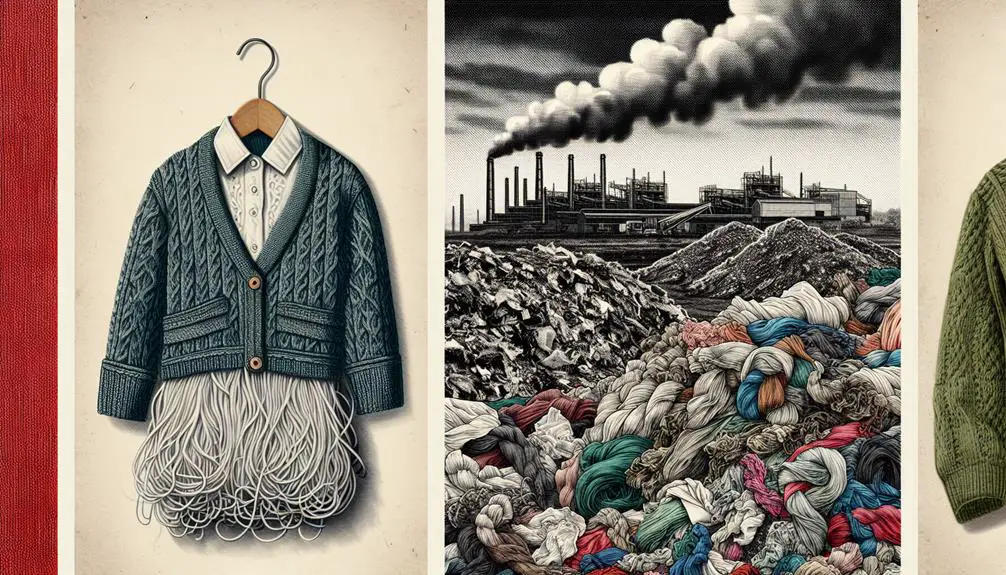I've noticed a few downsides to nylon that you might want to consider. First off, its production isn't great for the environment—it emits harmful gases and uses tons of water. It also doesn't break down easily, contributing to pollution with nasty microplastics. On top of that, nylon isn't breathable and can irritate your skin, especially if you're sweating or have sensitivities. It's also prone to holding onto stains and odors, which can be a real hassle. With all these issues, it's worth knowing what alternatives there are, especially if you're looking to make more eco-friendly choices.
Table of Contents
Key Takeaways
- Nylon production is environmentally harmful, emitting gases like nitrous oxide and using large amounts of water.
- It is not biodegradable, contributing to long-term environmental pollution.
- The material traps moisture and has limited breathability, causing discomfort and potential skin irritation.
- Nylon garments are prone to retaining odors and are challenging to clean, especially from oil-based stains.
- Recycling nylon is difficult due to its complex breakdown and reprocessing requirements.
Environmental Impact
Nylon's production process is seriously tough on our environment. Let's break it down a bit. First off, making nylon is super water-intensive and spews out harmful gases like nitrous oxide, which is a major climate change contributor. Plus, just moving this stuff around means a lot of CO2 emissions due to transportation.
Then there's the disposal issue. Nylon isn't friendly when it's time to throw it away because it doesn't break down easily. This means it sticks around in our environment for ages, causing long-term damage. And don't get me started on microplastics! Every time we wash nylon clothes, tiny fibers escape into water bodies, messing with aquatic life and ecosystems.
The whole cycle is energy-hungry too, ramping up the carbon footprint. Even though recycling advancements like Econyl are making headway, nylon's essentially a synthetic beast that's tough to tame environmentally.
Limited Breathability
Moving on to the breathability—or rather, the lack of it—in nylon fabrics, we've got some real drawbacks to cover.
First off, if you're in a humid climate, wearing nylon can feel like you're wrapped in plastic, making it super uncomfortable.
Plus, this material can irritate your skin and isn't the best choice for sports clothes, as it traps sweat and heat too easily.
Comfort in Humid Climates
In humid climates, wearing nylon can be pretty uncomfortable because it doesn't breathe well. Its non-absorbent nature means it doesn't soak up sweat, leaving you feeling sticky and clammy. Plus, nylon's poor moisture-wicking properties keep that sweat right on your skin. It doesn't evaporate like it would with more breathable fabrics.
This trapped moisture can make the fabric feel even heavier on your body. You know that feeling when your clothes just cling to you in the heat? That's what I'm talking about. It's like wearing a sticky, sweaty blanket. Not exactly what you want when it's already muggy and uncomfortable out.
Skin Irritation Risks
Due to its limited breathability, wearing nylon often leads to skin irritation by trapping moisture and heat against the body. This trapped moisture coupled with the lack of air circulation makes the skin a playground for discomfort and, potentially, chafing. It's not just about feeling sticky; the prolonged contact can even trigger allergic reactions for some folks. Choosing more breathable fabrics could be a smarter move for both comfort and skin health.
Here's a quick table to sum it up:
| Issue | Cause | Solution |
|---|---|---|
| Skin Irritation | Trapped moisture | Opt for breathable fabrics |
| Discomfort | Lack of air circulation | Choose looser clothing |
| Allergic Reactions | Prolonged wear | Limit nylon use |
| Chafing | Non-absorbent nature | Pick moisture-wicking materials |
| Sticky feeling | Sweat buildup | Wear lighter fabrics |
Athletic Wear Limitations
While skin irritation risks are significant, another key downside of nylon in activewear is its limited breathability.
When I'm hitting the gym or going for a run, I've noticed that nylon gear just doesn't let my skin breathe. This lack of breathability leads to moisture retention. Basically, sweat gets trapped against my skin, causing a lot of discomforts.
It's not just a matter of feeling sticky and uncomfortable either. This environment is perfect for bacteria to grow, which means my workout clothes can start to smell pretty bad, pretty fast.
Plus, without good moisture-wicking, I'm not getting the ventilation I need to stay cool and dry. That's why I tend to reach for more breathable fabrics for my workouts.
Allergic Reactions
Nylon can trigger allergic reactions for some people, especially those with sensitive skin. This synthetic material, often chosen for its durability and ease of care, mightn't always be the best choice for everyone. Here's why I'm wary of it:
- Skin Irritation: Nylon's synthetic nature means it doesn't let your skin breathe as natural fibers do. This can lead to discomfort and irritation, particularly if you've got sensitive skin.
- Allergic Reactions: Wearing nylon can result in nasty reactions like rashes, itching, and redness. Imagine going through your day trying to focus but ending up distracted by constant itching or discomfort.
- Chemicals and Dyes: The production of nylon involves various chemicals and dyes, which can further aggravate the skin. These aren't just irritating; they can cause more serious allergic responses.
- Sensitive Skin: If you already struggle with skin conditions, nylon might exacerbate your issues. It's like adding fuel to a fire.
For those with sensitivities, sticking to natural fibers might be the way to go. It's about knowing your body and choosing what truly works for you rather than just going with the flow. Remember, comfort shouldn't be a luxury!
High Energy Production
Now, let's talk about how making nylon isn't too kind on our resources.
First off, it's a big deal because the whole process needs a lot of energy, which means more pollution and a bigger carbon footprint.
And, don't forget, it uses up a ton of water too, which isn't great for our planet.
Resource-Intensive Manufacturing Process
The process of making nylon gobbles up a ton of energy and resources. It's seriously energy-intensive, not just in power usage but in the sheer volume of materials needed. Here's the lowdown:
- High Electricity Usage: Nylon production zaps a lot of juice, mainly for heat and to power equipment.
- Complex Chemical Processes: It's not a simple recipe. Multiple, complicated steps mean more resources and more energy.
- Raw Material Extraction: We're talking petrochemicals, which aren't just lying around. Getting these from the earth is a hefty task.
- Environmental Worries: With all these resources and energy, the environmental impact isn't just a footnote; it's a major concern.
It's a resource-intensive affair every step of the way, making us rethink its sustainability.
High Carbon Footprint
Building on the resource-heavy method needed to make nylon, its production also leaves a big carbon footprint. This happens mainly because of energy-intensive processes. When making nylon, a ton of energy is needed right from the start – extracting raw materials and processing them.
This isn't just about using a lot of energy; it's about what comes from using all that energy. We're talking serious greenhouse gas emissions. One of the big offenders is nitrous oxide, a greenhouse gas that really packs a punch in terms of climate change impact.
Significant Water Usage
Nylon's production not only skyrockets energy use but also guzzles an immense amount of water. It's surprising how much goes into making something so common, right? Here's a quick peek at why that's troubling:
- Massive Water Consumption: About 5.5 gallons to make just one pound of nylon!
- Water Pollution: If factories don't treat waste properly, it harms our rivers and lakes.
- Energy-Intensive Process: It's not just about the water; the energy demand is through the roof, worsening its environmental impact.
- Dyeing Adds More Issues: Dyeing nylon ups the water use and pollution even more.
Prone to Shrinkage
I've noticed that nylon tends to shrink when it gets too hot during washing or drying. This shrinkage isn't just annoying; it can really mess up the size and fit of your clothes over time. Imagine pulling out your favorite shirt only to find it's snug in all the wrong places!
To tackle this, I stick to the care instructions strictly. Washing nylon fabric in cold water and skipping the dryer, opting instead to air dry, can be a game changer. It's all about keeping the fabric away from high heat that could cause it to contract.
Learning how to handle nylon garments properly is crucial. Sure, it might need a bit more pampering in the laundry department, but getting this right means your clothes will keep their shape and look good for longer. So, always check the label and follow those guidelines closely. They're there for a reason!
Understanding the shrinkage tendencies of nylon has definitely helped me prolong the life and appearance of my nylon clothes. It's a simple step that goes a long way in maintaining your wardrobe. Remember, a little care goes a long way in preventing unwanted surprises after laundry day!
Non-Biodegradable Nature
One major drawback of nylon is its non-biodegradable nature, which contributes significantly to global plastic pollution. As someone who's deeply concerned about our environment, this fact really strikes a chord with me.
Nylon's inability to break down easily means it sticks around for ages, piling up in our landfills and oceans. Here's a quick look at the emotional impact of this reality:
- Visual Impact: Imagine our beautiful beaches and parks littered with nylon waste. Not a pretty sight, right?
- Wildlife Distress: Animals often mistake nylon for food, leading to fatal consequences. It's heartbreaking to think about.
- Ecosystem Imbalance: Nylon waste disrupts habitats and harms biodiversity. The thought of damaged ecosystems keeps me up at night.
- Future Generations: What kind of world are we leaving behind? The idea that our kids might inherit a polluted planet is deeply troubling.
While recycling nylon can help to some extent, it's not a complete solution due to existing challenges. We're talking about a material that's tough to break down and reprocess. This contributes massively to waste accumulation, compounding the problem of plastic pollution. Honestly, it's a cycle that we need to address sooner rather than later.
Susceptibility to Stains
Moving beyond environmental concerns, another issue with nylon is its tendency to stain easily. If you've ever dropped a bit of salad dressing or splattered some oil while cooking, you've probably noticed how those spots seem to cling stubbornly to nylon fabrics. This is because nylon is particularly prone to oil-based stains, which aren't just visible but also tough to wash out.
What's more, nylon can retain odors, making it less than ideal for active wear or kitchen use where smells are part of the package. Imagine going for a jog or cooking a meal, and your clothes hold onto those smells long after you're done. It's not pleasant!
To tackle these issues, regular cleaning is essential. You can't just toss nylon items in with all your other laundry and hope for the best. Specific cleaning methods and products designed for synthetic fabrics can help minimize these staining and odor retention problems. It's all about being proactive with your care routine to prevent these nuisances from becoming permanent. So, while nylon has its perks, it definitely demands a bit more attention on the cleaning front to keep it looking and smelling fresh.
Frequently Asked Questions
What Are the Pros and Cons of Nylon?
I'm looking at nylon's pros and cons. It's durable, colorfast, light, and resists mold. But, it's not breathable and its production harms the environment since it's energy-heavy and doesn't break down easily.
What Is Nylon Bad For?
I've learned that nylon's really bad for the environment because it's made from petroleum and doesn't break down easily. Plus, it's not breathable, which can be super uncomfortable in the heat.
Why Not to Use Nylon?
I avoid using nylon because it's not breathable, traps odors, and isn't eco-friendly. It contributes to pollution during production and isn't biodegradable, which harms our environment more than natural alternatives.
What Are the Side Effects of Nylon?
I've noticed nylon can irritate my skin, making it itchy and uncomfortable. It also traps sweat and odors, which means I'm washing my clothes more often to keep them feeling fresh.
- Tetron Fabric in the Textile Industry: An Overview - June 17, 2025
- Tetron Fabric for Medical Use: Benefits and Applications - June 17, 2025
- Tetron Fabric for Industrial Applications: A Comprehensive Guide - June 17, 2025






